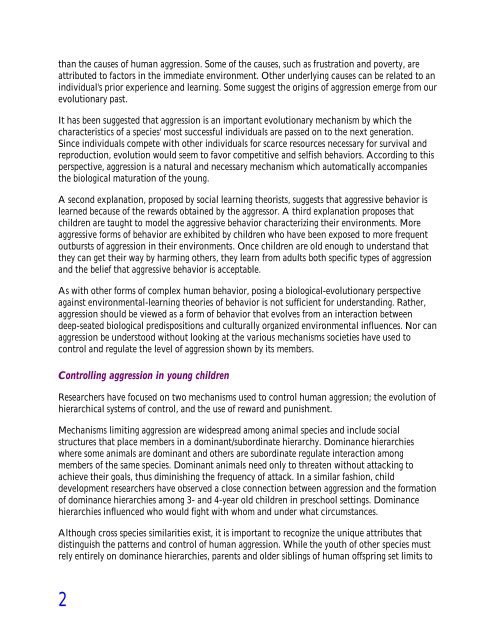the development of aggression and prosocial behavior in
the development of aggression and prosocial behavior in
the development of aggression and prosocial behavior in
You also want an ePaper? Increase the reach of your titles
YUMPU automatically turns print PDFs into web optimized ePapers that Google loves.
than <strong>the</strong> causes <strong>of</strong> human <strong>aggression</strong>. Some <strong>of</strong> <strong>the</strong> causes, such as frustration <strong>and</strong> poverty, are<br />
attributed to factors <strong>in</strong> <strong>the</strong> immediate environment. O<strong>the</strong>r underly<strong>in</strong>g causes can be related to an<br />
<strong>in</strong>dividual's prior experience <strong>and</strong> learn<strong>in</strong>g. Some suggest <strong>the</strong> orig<strong>in</strong>s <strong>of</strong> <strong>aggression</strong> emerge from our<br />
evolutionary past.<br />
It has been suggested that <strong>aggression</strong> is an important evolutionary mechanism by which <strong>the</strong><br />
characteristics <strong>of</strong> a species' most successful <strong>in</strong>dividuals are passed on to <strong>the</strong> next generation.<br />
S<strong>in</strong>ce <strong>in</strong>dividuals compete with o<strong>the</strong>r <strong>in</strong>dividuals for scarce resources necessary for survival <strong>and</strong><br />
reproduction, evolution would seem to favor competitive <strong>and</strong> selfish <strong>behavior</strong>s. Accord<strong>in</strong>g to this<br />
perspective, <strong>aggression</strong> is a natural <strong>and</strong> necessary mechanism which automatically accompanies<br />
<strong>the</strong> biological maturation <strong>of</strong> <strong>the</strong> young.<br />
A second explanation, proposed by social learn<strong>in</strong>g <strong>the</strong>orists, suggests that aggressive <strong>behavior</strong> is<br />
learned because <strong>of</strong> <strong>the</strong> rewards obta<strong>in</strong>ed by <strong>the</strong> aggressor. A third explanation proposes that<br />
children are taught to model <strong>the</strong> aggressive <strong>behavior</strong> characteriz<strong>in</strong>g <strong>the</strong>ir environments. More<br />
aggressive forms <strong>of</strong> <strong>behavior</strong> are exhibited by children who have been exposed to more frequent<br />
outbursts <strong>of</strong> <strong>aggression</strong> <strong>in</strong> <strong>the</strong>ir environments. Once children are old enough to underst<strong>and</strong> that<br />
<strong>the</strong>y can get <strong>the</strong>ir way by harm<strong>in</strong>g o<strong>the</strong>rs, <strong>the</strong>y learn from adults both specific types <strong>of</strong> <strong>aggression</strong><br />
<strong>and</strong> <strong>the</strong> belief that aggressive <strong>behavior</strong> is acceptable.<br />
As with o<strong>the</strong>r forms <strong>of</strong> complex human <strong>behavior</strong>, pos<strong>in</strong>g a biological-evolutionary perspective<br />
aga<strong>in</strong>st environmental-learn<strong>in</strong>g <strong>the</strong>ories <strong>of</strong> <strong>behavior</strong> is not sufficient for underst<strong>and</strong><strong>in</strong>g. Ra<strong>the</strong>r,<br />
<strong>aggression</strong> should be viewed as a form <strong>of</strong> <strong>behavior</strong> that evolves from an <strong>in</strong>teraction between<br />
deep-seated biological predispositions <strong>and</strong> culturally organized environmental <strong>in</strong>fluences. Nor can<br />
<strong>aggression</strong> be understood without look<strong>in</strong>g at <strong>the</strong> various mechanisms societies have used to<br />
control <strong>and</strong> regulate <strong>the</strong> level <strong>of</strong> <strong>aggression</strong> shown by its members.<br />
Controll<strong>in</strong>g <strong>aggression</strong> <strong>in</strong> young children<br />
Researchers have focused on two mechanisms used to control human <strong>aggression</strong>; <strong>the</strong> evolution <strong>of</strong><br />
hierarchical systems <strong>of</strong> control, <strong>and</strong> <strong>the</strong> use <strong>of</strong> reward <strong>and</strong> punishment.<br />
Mechanisms limit<strong>in</strong>g <strong>aggression</strong> are widespread among animal species <strong>and</strong> <strong>in</strong>clude social<br />
structures that place members <strong>in</strong> a dom<strong>in</strong>ant/subord<strong>in</strong>ate hierarchy. Dom<strong>in</strong>ance hierarchies<br />
where some animals are dom<strong>in</strong>ant <strong>and</strong> o<strong>the</strong>rs are subord<strong>in</strong>ate regulate <strong>in</strong>teraction among<br />
members <strong>of</strong> <strong>the</strong> same species. Dom<strong>in</strong>ant animals need only to threaten without attack<strong>in</strong>g to<br />
achieve <strong>the</strong>ir goals, thus dim<strong>in</strong>ish<strong>in</strong>g <strong>the</strong> frequency <strong>of</strong> attack. In a similar fashion, child<br />
<strong>development</strong> researchers have observed a close connection between <strong>aggression</strong> <strong>and</strong> <strong>the</strong> formation<br />
<strong>of</strong> dom<strong>in</strong>ance hierarchies among 3- <strong>and</strong> 4-year old children <strong>in</strong> preschool sett<strong>in</strong>gs. Dom<strong>in</strong>ance<br />
hierarchies <strong>in</strong>fluenced who would fight with whom <strong>and</strong> under what circumstances.<br />
Although cross species similarities exist, it is important to recognize <strong>the</strong> unique attributes that<br />
dist<strong>in</strong>guish <strong>the</strong> patterns <strong>and</strong> control <strong>of</strong> human <strong>aggression</strong>. While <strong>the</strong> youth <strong>of</strong> o<strong>the</strong>r species must<br />
rely entirely on dom<strong>in</strong>ance hierarchies, parents <strong>and</strong> older sibl<strong>in</strong>gs <strong>of</strong> human <strong>of</strong>fspr<strong>in</strong>g set limits to<br />
2
















